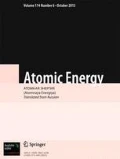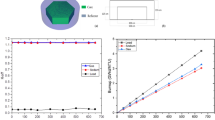Abstract
A large change in the structure, density, and chemical and phase composition occurs in nuclear fuel with deep burnup, and an edge zone is formed. Simulation of the formation of an edge zone in a fuel kernel of thermal reactors will make it possible to suggest ways to decrease its influence on the characteristics of a fuel element. In the present work, the neutron-physical processes occurring in the peripheral layer of a fuel kernel are simulated. The distribution of nuclear reaction rates along the radius of a fuel pellet is calculated using the SCALE-4.3, MCNP-4B, and UNK computer programs. The radial dependence of the local breeding ratio is calculated. It is shown that for fresh fuel BR > 1 for fissile nuclei in a 100 µm thick layer, while the initial BR averaged over a pellet is no more than 0.5. The volume energy distribution in a 100 µm thick peripheral layer is 30% higher than the average value over a pellet. A combined pellet, where the central part possesses the standard enrichment (4–5% 235U) and the peripheral layer contains less than 0.7% 235U, is proposed to decrease the influence of the edge zone on the properties of fuel.
Similar content being viewed by others
References
J. Piron, B. Bordin, G. Geoffroy, et al. “Fuel microstructure and RIM effect at high burnup,” in: Proceedings of International Topical Meeting on Light Water Reactor Fuel Performance, Florida, USA, April 17–21, 1994, pp. 321–327.
A. S. Shcheglov, V. D. Sidorenko, V. N. Proselkov, et al., “Formation and development of a surface layer in a VVER-440 fuel kernel,” At. Énerg., 80, No. 3, 221–223 (1996).
S. Yu. Kurchatov, V. V. Likhanskii, A. A. Sorokin, and O. V. Khoruzhii, “Simulation, using the RTOP code, of the radial profiles of heat release and accumulation of plutonium isotopes in high burnup UO2 fuel,” At. Énerg., 92, No. 4, 317–324 (2002).
V. V. Likhanskii, O. V. Oruzhii, A. A. Sorokin, et al., “Development of a physical model of microstructural changes in UO2 fuel with high burnup (model of the formation of an edge layer),” TRINITI Report No. GR.01.20.02.10135, Inv. No. 10/NIR-5638, November 28, 2003.
SCALE: A Modular Code System for Performing Standardize Computer Analyses for Licensing Evaluation, ORNL/NUGER/CSD-2/R4 (1993).
MCNP — a General Monte Carlo N-Particle Transport Code, Version 4B, LA-12625-M (1997).
N. I. Belousov, V. D. Davidenko, and V. F. Tsibul’skii, “UNK computer program for detailed calculation of the spectrum in the cell of a nuclear reactor,” Preprint IAÉ-6083/4 (1998).
A. Romano, M. Horvath, and R. Resfani, “Evolution of porosity in the high burnup fuel structure,” J. Nucl. Mater., 361, 62–68 (2007).
Author information
Authors and Affiliations
Additional information
__________
Translated from Atomnaya Énergiya, Vol. 104, No. 6, pp. 353–358, June, 2008.
Rights and permissions
About this article
Cite this article
Andrianov, A.N., Baranov, V.G., Tikhomirov, G.V. et al. Simulation of neutron-physical processes in the surface layer of a fuel kernel. At Energy 104, 463–469 (2008). https://doi.org/10.1007/s10512-008-9056-3
Received:
Published:
Issue Date:
DOI: https://doi.org/10.1007/s10512-008-9056-3




